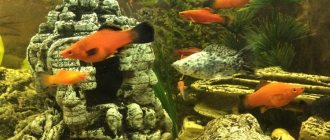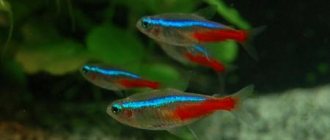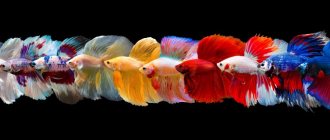In fact, such turtles exist and can be easily purchased at a pet store. But before you go to the pet store, it’s a good idea to familiarize yourself with the conditions under which they are kept. Nowadays, it is difficult to find a person who would not look for at least something on the Internet, where you can really find any information on any topic.
Types of small turtles for home keeping
Small turtles are usually called those species that during their life do not grow in length more than 12 cm. If an adult is large in size, then it is no longer a miniature turtle, but a medium-sized turtle that requires completely different care. If an adult is no more than 12 cm in length, then this is what you need. At the same time, you should know that a young individual can have very small sizes: only a few cm. But, over time, it will definitely grow up and will look exactly like the type of turtle that was declared by the pet store seller. This factor must be taken into account and the living space for the animal must be prepared for the future.
Feeding
A turtle's diet is based on the needs of a particular species. The majority is food of animal origin, supplemented by permitted vegetables. You can feed turtles with special dry food, but only high-quality food and no more than once a week.
Fish and seafood
What is the best way to feed a turtle? The basis of nutrition for waterfowl turtles of any kind is low-fat small fish. Live is preferred, but not required.
The following types are suitable:
- cod;
- hake;
- perch;
- crucian carp
Fish caviar (raw!) is a real delicacy for turtles; it can and should also be offered to your pets.
It is not recommended to feed turtles with fatty fish, such as:
- capelin;
- sprat;
- sprat
The diet will also be enriched with raw seafood:
- squid;
- crabs;
- crayfish;
- shrimps;
- mussels;
- scallops;
- octopuses.
Plant food
You can give it no more than twice a week, preferably less often.
Suitable:
- dandelion leaf, plantain leaf;
- lettuce and cabbage;
- seaweed (dry);
- apples, bananas, pears;
- carrots, cucumbers, pumpkin.
Meat
Once a week you are allowed to treat your turtle to lean poultry or lean beef. It is more beneficial to give chicken or beef liver in small quantities.
Insects
The following insects are suitable in dry or fresh (even live) form:
- zoophobus;
- mealworm;
- cricket;
- locusts;
- snails;
- bloodworm;
- gammarus;
- earthworms;
- cockroaches (ash, periplanets);
- wax moth larvae;
It is not advisable to feed a turtle this food more than once a week, and it is allowed to feed moth larvae no more than once a month.
Where to feed, how often
It is recommended to organize feeding in the same place in the aquarium. The amount of food given to the animal at one time should be eaten by it within 20 minutes. As soon as the reptile begins to get distracted and scatter pieces of food, it means it has had enough and no longer needs it. It is recommended to remember this volume.
Babies are fed daily, often twice a day, dividing the daily amount of food into morning feeding and evening feeding, and adults are fed in one meal every two or three days.
Prohibited Products
It is strictly forbidden to feed your turtle food that has undergone heat treatment, especially fried food.
The following should not be included in the diet:
- spinach;
- peas;
- radish;
- cauliflower;
- mushrooms;
- pineapples;
- citrus fruit;
- nuts;
- porridge;
- dairy and fermented milk products;
- bakery products;
- crab sticks.
It is also prohibited to give seeds and seeds of permitted fruits and vegetables.
Flathead or flat-bodied turtles
This type of turtle grows up to 8-9 cm in length, with a weight ranging from 100 to 200 grams. These small and amazing creatures are very unpretentious to keep. The fact is that they feed on succulent plants, the stems of which contain a lot of moisture. Therefore, caring for these babies is so simple that it can be entrusted to children. Due to the fact that these turtles are not at all demanding of care, they can be recommended to all novice turtle keepers. The practical skills gained through the process of caring for these animals will definitely be useful in the future.
How to determine age and gender?
It is possible to determine the sex of a turtle only after it reaches the age of sexual maturity. But even in adult individuals, the differences between males and females remain very blurred and sex determination is possible only by secondary characteristics. The most notable include:
- Claws on the hind limbs. In males they are long, sometimes curved and thickened.
- Tail. The male is wide at the base, long with a narrow tip.
- Size. Females are noticeably larger.
- Shell shape. In males it is longer and narrower.
- The structure of the abdominal part of the external skeleton. The plastron of females is smooth, while that of males is concave.
Please note: some differences are subtle or may be absent altogether, so conclusions are drawn based on several signs.
To obtain more reliable data, you can use scientific methods - blood tests for hormones, radiography and ultrasound.
Finding out how old a reptile is is an even more difficult task. The easiest way is to clarify this point with the seller. If this is not possible, then the date of birth can only be determined approximately. The error will be several years.
One of the most reliable ways to find out the age is to measure the turtle's shell with a ruler from the front to the back edge, without taking into account the bend. By one year, its length should be three to four centimeters.
In the future, sizes depend on gender:
- 2 years. Females - 9 cm, males - 8 cm;
- 3 years. Females – 14 cm, males – 10 cm;
- 4 years. Females – 17 cm, males – 12 cm.
In addition, you can find out your age:
- Counting the rings on the shell. The first is formed before the turtle reaches twelve months. Every year 2–3 rings are added to the pattern.
- By color. The darker the shell, the older the animal. Young turtles (up to 4 years old) have rich, bright colors, then the shell begins to gradually darken.
Locking turtles
Under natural conditions, this type of turtle can actually be found in Mexico, America, and also in Africa. Scientists know about 4 species of these little ones, but the Sonoran and yellow turtles are the most widespread. They can grow up to 13 cm in length. As for the other two subspecies, which include striped and mud turtles, they grow in length only up to 11 cm.
Reproduction
Whether a turtle is sexually mature or not depends on its size. Approximately: 2-4 years for a male and a shell of more than 10 cm and 2-5 years for a female and 12-13 cm.
Mating games begin with a sexually mature male (although young ones can also try), with a kind of courtship. During which he swims in front of the female, with his muzzle towards her and waves his paws very quickly in front of her eyes.
In nature, breeding occurs in March and June, but domestic turtles can mate throughout the year.
When a turtle is pregnant, that is, carrying eggs, you need to prepare a special place for her where she will lay these eggs. A female can carry eggs without a male, but they will not be fertilized!
You can gently feel the eggs between the carapace and her hind legs, but be careful, they are very fragile. The female will instinctively look for a place to nest and lay eggs.
A clutch can contain up to 20 eggs for a large female. If the conditions are suitable, then the female lays up to 3-4 clutches per season.
In a home aquaterrarium, the female signals preparation for reproduction by changing her behavior.
She becomes very restless, imitates digging movements with her hind legs and tries to get out of the aquarium. Also during this time, she spends more time on land and needs calcium and UV rays.
The place where she can lay her eggs is very important; if there is not one, she will lay them in the water or even carry them further, which will cause them to harden.
If you see that a turtle has laid one or two eggs, try to make a nest for it. Most likely, the rest of the clutch has not yet hatched and she is still pregnant.
If the female does not lay eggs, they will harden and can cause infection and death of the animal.
Even a properly prepared nest is not a guarantee that everything will go well, since the turtle may be old, tired, or sick.
If she tries to lay her clutch, but nothing works, then it is better to take her to the veterinarian.
Possible signs of problems: decreased activity, heavy breathing, depressions or swelling near the cloaca.
If there is an unpleasant liquid coming out of it or there is an odor, then the eggs inside may have broken. If you have any health problems with your red-eared slider, contact your veterinarian immediately!
Three-keeled Chinese turtles
The average size of adult individuals ranges from 13 cm. Among other things, this species of turtle has an attractive appearance and a rather calm character. Such characteristics contribute to the fact that three-keeled Chinese turtles become the favorites of many turtle keepers. Plus, they do not require special conditions of detention. This factor is considered ideal for those who for the first time in their life decided to have a turtle at home.
Care
A water turtle at home, of course, requires constant care, albeit not energy-consuming.
Basic principles of care:
- it is necessary to monitor the behavior of the reptile and its state of health daily;
- make sure that the water in the terrarium remains clean and change it on time;
- when changing the water in the terrarium, it is necessary to thoroughly rinse all decorative elements;
- replace gravel in a timely manner and ensure its cleanliness;
- feed the animal in accordance with the requirements of the species, on time;
- enrich the diet with special mineral supplements;
- start treatment in a timely manner if alarming symptoms occur.
The class of aquatic aquarium turtles is really undemanding in care and maintenance.
What to look for when purchasing
Aquatic turtles are quite active creatures. A healthy animal shows interest in everything that is happening, eats well, and its reflexes work perfectly (for example, in case of the slightest danger, the reptile quickly hides in its shell). It is recommended to purchase a turtle from a trusted pet store or nursery, where there is no doubt about the living conditions created for the animals. When purchasing, the main criteria for evaluating a turtle will be its activity and appearance.
A properly raised young reptile has the following characteristics:
- smooth and clean shell without plaque or damage;
- clear, clean eyes, without wounds and suppuration;
- active swimming;
- good reflexes and movement of limbs.
It is also worth noting that a truly healthy animal is simply pleasant to look at.
Important! Aquarium turtles that live with fish should be small, and the fish, accordingly, should be large enough so that they are not perceived as food by the reptiles.
How to pick up
To communicate with an animal, you need to learn how to hold it correctly. The turtle is picked up under the belly, if it is small, and held in the palm of your hand, while larger animals are taken with both hands on the sides of the shell and be sure to grab the belly.
A turtle, like any animal, needs to be taught to be touched gradually. If your pet hisses or tries to hide, you should not force him to communicate. When the animal has become accustomed to the owner and his hands, you can sit him on your hand or knee, but it is not advisable to keep him in a canopy for a long time - this is unpleasant for turtles.
Changing water
The amount of water is indicated in the requirements for keeping the species, but the general criterion for quality is purity. Accordingly, the water should be changed at least once a month, and more often if it is heavily polluted.
Hibernation
It is extremely difficult to properly hibernate a reptile at home. If the animal is active and does not show signs of wanting to “winter”, you should not artificially create conditions for it. Improper hibernation can cause irreparable harm to the body.
Benefits of keeping baby turtles
Many people dream of having some kind of exotic animal live in their home. It is worth noting that in some apartments you can find pythons, lizards, snakes, etc. Unfortunately, most apartments are not large enough to accommodate a crocodile, for example. Although rare, such an animal can be found.
As for the turtle, this is what is needed. Firstly, this is a completely harmless animal that will not harm anyone, including children, and secondly, a small turtle takes up very little living space. And feeding a small animal is always much easier. In addition, caring for such a pet can be entrusted to a teenager. He will not only become familiar with the living conditions of this animal and its habits, but will also learn to love nature in general, and not just pet turtles.
Where to keep a mini turtle
For the normal existence and development of an aquatic miniature turtle, you will need a 100-150 liter aquarium. As for the land species, a small terrarium is enough. At the same time, you need to know about the minimum and maximum temperatures so that your pet feels comfortable. It’s also a good idea to know about his diet. You need to know that all pet turtles are representatives of hot countries that need suitable temperature and humidity. Only with this approach will your pet be always healthy and delight others with its activity.
If these conditions are violated, then you need to be prepared for very unpleasant surprises. You should know that it is better to prevent negative consequences than to get rid of them later. The first thing that can happen is that the turtle gets sick, and treating such a baby, especially on your own, is very difficult and you can’t do it without a specialist herpetologist. And this, after all, is not only a loss of precious time, but also a waste of money. At the same time, we should not forget about the psychological aspect.
The most common breeds of aquarium turtles
Such pets need comfortable conditions, high-quality and regular care, and an equipped tank. However, even such needs do not scare off owners - many decide to have such reptiles. But how can you choose the most suitable pet among the abundance of breeds, because they differ in size, behavior, character? It is worth considering the most popular representatives.
Red-eared (yellow-bellied) turtle
In an aquarium, these animals, whose homeland is North America, can live for a quarter of a century. Reptiles are colored greenish, and behind each of the eyes there are stripes of a bright, scarlet hue. Males have a long, compacted tail, elongated claws on their forelimbs, and their dorsal shield is smaller than that of females. The plastorn is an abdominal shield, of a concave type, while in females it is straight.
The red-eared turtle is an aquatic species, so it needs a tank of water. Young individuals prefer animal food - they eat fish, shellfish, and insects. As they grow older, their gastronomic preferences change, and reptiles switch to a plant-based diet.
It is recommended to feed aquarium pets variedly, giving them foods containing plant and animal proteins. To keep the tank clean much longer, it is advisable to give your pet food outside of it. Naturally, the meal will require more time and attention from the owner.
For a comfortable life for an exotic pet, you need to purchase an aquarium with a volume of at least 150 liters. Only in a spacious tank will the red-bellied turtle feel good. A quarter of the container should be occupied by a sloping bank; it should be installed in such a way that the earthen embankment does not end up in the water.
Water should be prepared in advance: cleaned, settled, temperature 20°-22°C. It is replaced every week; filtering is not necessary, but acceptable. It is advisable to equip the tank with an additional source of ultraviolet rays and illumination.
In the summer, when the aquarium is constantly illuminated by sunlight, red-eared turtles begin to reproduce. It is recommended to place duckweed and filamentous algae in the tank.
Emys orbicularis (European swamp)
The reptile has a small carapace, the length of which is approximately 20 cm. But the limbs have large nail plates and webbed feet. Almost the entire body and shell are covered with small spots, lighter than the main color.
They choose reservoirs with fresh water and a bottom covered with a layer of silt as their habitat. They hunt mainly in the daytime, feeding on various small animals. Among domestic turtles, the marsh turtle is distinguished by its decent size - the weight of individuals reaches 2 kg.
The reptile has an elongated tail, which helps it regulate its trajectory while moving in the water. In adult turtles, the shell becomes dark - brownish, brownish or deep olive, with yellow specks on the main background. Eyes – yellow or orange.
These reptiles are capable of staying under water for a long time, being excellent swimmers. Almost any live food can be used as food - from larvae to small crustaceans and fish. You can give food yourself or place it on a special hanging feeder. Swamp turtles swallow food only while in the water. You cannot include minced meat in your pet's diet.
European turtles are kept in spacious 150-200-liter aquariums, in which equipment is installed like “artificial islands” that form a coastline. Medium and large stones are used as soil.
Water can be filtered. Suitable water temperature varies from 25° to 28°C, the depth should be no more than 20 cm. In addition, the tank must be equipped with additional devices:
- heating lamps that do not provide light;
- UV lamp;
- low-pressure mercury gas-discharge lighting device (fluorescent);
- thermometer;
- aquafilter;
- an aquarium heater with which you can regulate the water temperature.
If a pet is provided with proper care, its life expectancy can be about three decades. In addition to these popular aquarium inhabitants, there are several breeds of smaller turtles that are kept as pets.










